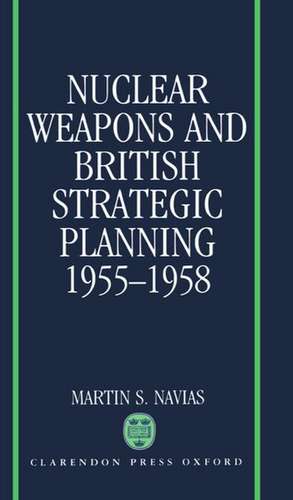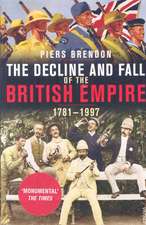Nuclear Weapons and British Strategic Planning, 1955-1958: Nuclear History Program, cartea 1
Autor Martin S. Naviasen Limba Engleză Hardback – 16 mai 1991
Preț: 1211.79 lei
Preț vechi: 1845.12 lei
-34% Nou
Puncte Express: 1818
Preț estimativ în valută:
231.91€ • 241.22$ • 191.45£
231.91€ • 241.22$ • 191.45£
Carte tipărită la comandă
Livrare economică 03-09 aprilie
Preluare comenzi: 021 569.72.76
Specificații
ISBN-13: 9780198277545
ISBN-10: 0198277547
Pagini: 280
Dimensiuni: 145 x 223 x 22 mm
Greutate: 0.5 kg
Editura: Clarendon Press
Colecția Clarendon Press
Seria Nuclear History Program
Locul publicării:Oxford, United Kingdom
ISBN-10: 0198277547
Pagini: 280
Dimensiuni: 145 x 223 x 22 mm
Greutate: 0.5 kg
Editura: Clarendon Press
Colecția Clarendon Press
Seria Nuclear History Program
Locul publicării:Oxford, United Kingdom
Cuprins
Introduction; Nuclear weapons and British Alliance commitments 1955-1956; The services and war planning in the thermonuclear era 1955-1956; The nuclear deterrent 1955-1956: Moving towards independence?; The Sandys White Paper of 1957; Independent deterrence and Anglo-American Co-operation: 1957-1958; Conclusion
Recenzii
`he has used a wide range of material very carefully. The book is based upon his doctoral thesis, but it has been reworked and amplified, and fairly reflects the intricacy of a period when most of the new truths that seemed to be emerging were insistent and uncomfortable.'The RUSI Journal
`authoritative ... scholarly and very competently structured'Political Studies
'Martin Navias's book represents the first major British contribution to the Nuclear History Program research effort ... In this post-cold war era, nuclear history has emerged as a rich vein of scholarly enquiry. The main theme of this interesting and well-researched book is continuity and change in British strategic policy during the mid-to-late 1950s. Navias has produced the most scholarly study yet available on the evolution of British strategic planning in the late 1950s. The study makes a major contribution to the literature on the subject. Its novel, if controversial, interpretation of the Sandys white paper helps to breathe fresh life into the debates about British strategy in this formative period of the nuclear age. It represents an impressive start to the NHP publication list.' John Baylis, University College of Wales, International History Review, XIV, 3, Aug '92
'Martin S. Navias's book is a fascinating study of the formulation of the 1957 White Paper ... an insightful portrait of British nuclear planning and a very useful contribution to nuclear history ... Students of postwar British military policy and nuclear history will find much value in Navias' book. Through its rich detail and extensive employment of original government documents, the book contributes to our understanding of a number of important themes ... Navias's work will be of great interest to scholars working with these - and many other - themes in miltary policy.'^:LPeter J. Roman, University of Wisconsin-Madison, Albion, Winter 1992
`authoritative ... scholarly and very competently structured'Political Studies
'Martin Navias's book represents the first major British contribution to the Nuclear History Program research effort ... In this post-cold war era, nuclear history has emerged as a rich vein of scholarly enquiry. The main theme of this interesting and well-researched book is continuity and change in British strategic policy during the mid-to-late 1950s. Navias has produced the most scholarly study yet available on the evolution of British strategic planning in the late 1950s. The study makes a major contribution to the literature on the subject. Its novel, if controversial, interpretation of the Sandys white paper helps to breathe fresh life into the debates about British strategy in this formative period of the nuclear age. It represents an impressive start to the NHP publication list.' John Baylis, University College of Wales, International History Review, XIV, 3, Aug '92
'Martin S. Navias's book is a fascinating study of the formulation of the 1957 White Paper ... an insightful portrait of British nuclear planning and a very useful contribution to nuclear history ... Students of postwar British military policy and nuclear history will find much value in Navias' book. Through its rich detail and extensive employment of original government documents, the book contributes to our understanding of a number of important themes ... Navias's work will be of great interest to scholars working with these - and many other - themes in miltary policy.'^:LPeter J. Roman, University of Wisconsin-Madison, Albion, Winter 1992






















